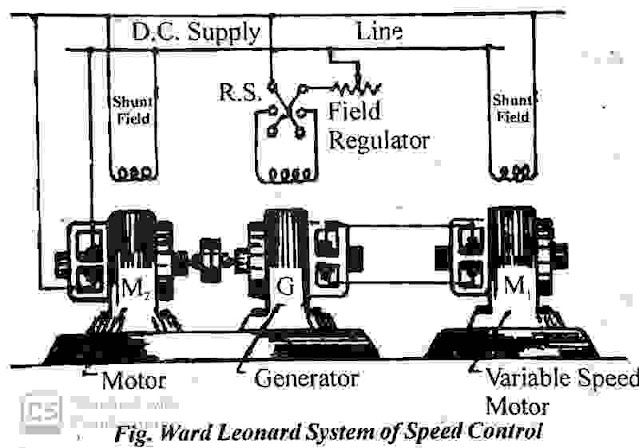Ward Leonard Method
Ward Leonard's method is introduced by Henry Ward Leonard in 1891. Ward Leonard's method of speed control is employed for controlling the speed of a DC motor. it's a basic armature control method.
This system is consisting of a DC motor M and is powered by a DC generator G. during this method the speed of the DC motor (M) is controlled by applying a variable voltage across its armature.
This variable voltage is obtained employing a motor-generator set which consists of motor M., (either AC or DC motor) directly including the generator G. it's a really widely used method of speed control of DC motor.
Principle of Ward Leonard Method
The basic connection diagram of the Ward Leonard speed system is shown in the figure below. The speed of motor M is to be controlled which is powered by generator G.The shunt field of motor M is connected across the DC supply lines. Now, generator G is driven by motor M, The speed of motor M is Constant. When the output voltage of the generator is fed to motor M, then the motor starts to rotate.
When the output voltage of the generator varies then the speed of the motor also varies. Now controlling the output voltage of the generator the speed of the motor also can be controlled.
The direction of rotation of the motor M is often reversed by excitation of the current of the generator and it can be done with the help of the reversing switch R.S. But the motor-generator set must run within the same direction.
Advantages of Ward Leonard Method
1. it's a really smooth speed system over a really wide selection (from zero to normal speed of the motor).2. The speed is often controlled in both the direction of rotation of the motor easily.
3. The motor can run with uniform acceleration.
4. Speed regulation of the DC motor during this Ward Leonard system is extremely good.
5. It has inherent regenerative braking properties.
Disadvantages of the Ward Leonard Method
I. The system is very costly because two extra machines (motor-generator set) are required.2. The overall efficiency of the system is not sufficient especially if it is lightly loaded.
3. Larger size and weight. Requires more floor area.
4. Frequent maintenance.
5. The drive produces more noise.
Application of Ward Leonard Method
This Ward Leonard method of the speed system is employed where very wide and really sensitive speed control may be a of DC motor in both the direction of rotation is required.This speed system is especially utilized in colliery winders, cranes, electric excavators, mine hoists, elevators, steel rolling mills, paper machines, diesel locomotives, etc.
